| |
 |
In the
chart, Mathematica accurately yields 0.2 at each step if
sufficient extended precision was specified at the start. If not, its
full output form alerts the user to the precision collapse (step 19 of
the blue line). By contrast the non-Mathematica system can only
work with
16-digit precision--yet results are produced for any number of steps,
however erroneous and whether or not the fixed 16-digit input
precision justifies the output. |
|
 |
Mathematica's extended-precision computation (EPC) supports almost
any length of integer and precision of real or complex numbers--unlike
non-Mathematica, numerical-only systems, which work to machine precision
or around 16
digits.
As well as being required for high-precision answers, EPC is often a
crucial factor in achieving accurate low-precision answers because
intermediate computation stages can drain precision--sometimes
dramatically. Complementing EPC, precision tracking is also built into
Mathematica.
|
 |


